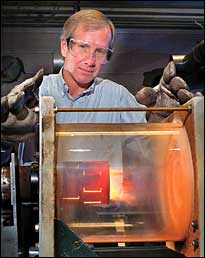The materials we use - the plastics, nylons and foams - are limited due to the structures of the petroleum-based chemical starting materials. However, if we can understand how to engineer unique plant enzymes of this type, we can produce unique chemicals with optimal properties, rather than relying on the properties of existing materials

If your experiment is not going as expected, you should take a closer look - something much more interesting may have happened. This strategy led scientists from the US Department of Energy to the discovery of a significant deviation in the function of an enzyme that may expand the tools of the engineers of biofuels and other petroleum-based products.
The researchers tried to understand the factors affecting carbon-carbon double bonds found in fatty acids, the building blocks of oils and fats, when they undergo a process in which the desaturase enzyme removes a hydrogen atom from the carbon skeleton.
"Creating double bonds in different positions on the carbon skeleton makes it possible to change the structure of fatty acids to prepare products with different applications," explains biochemist John Shanklin, who led the research. The main goal is the planned production of vegetable oils that can be used as biofuels and/or materials that will help reduce the use of oil.
In order to try and change the position of the double bond, the research team made changes to the structure of the desaturase enzyme, changing three amino acids out of the 363 acids that make up the protein. However, when they examined the engineered enzyme and hoped to find the expected product with the different position of the double bond - it was not there.
More on biodiesel on the science website
- Transgenic bacteria enable the production of biofuel
- Fuel from wood chips and agricultural waste
- Bio mass bricks instead of fossil fuel
They could have moved on and replaced other amino acids in sequence until the expected product was obtained. But research associate Edward Whittle was determined to understand why this unexpected result was obtained. "The substrate, the source material, underwent a change and disappeared, therefore something else had to be created - materials cannot just disappear like that," says the researcher. "If our expected product is not created, what exactly is created"?
The investigator's detective work led to a sensational discovery. Instead of creating a change in the position of the double bond, the engineered enzyme led to the creation of three completely new substances - two derivatives of a hydroxylated product known as an allyl alcohol and a fatty acid with two double bonds. "This was a significant change in the function of the enzyme," explains the lead researcher, who has been working with engineered enzymes for fifteen years. "Usually, you cause gradual changes so that a small percentage of a new product is obtained in the mixture with the starting material. In our case it was an almost complete change in the function of the enzyme."
The discovery is also noteworthy due to the fact that the original enzyme, similar to other soluble desaturase enzymes (which do not depend on the cell membrane), is only able to perform the one reaction unique to it - removal of hydrogen to obtain a double bond. This is in contrast to enzymes of this type that exist within the cell membrane, which are more versatile and perform a variety of reactions. However, these two types of enzymes have one key feature in common - both carry out reactions that require the existence of a highly active form of oxygen.
"Since both types of enzymes produce active oxygen, in theory the soluble enzymes, similar to their counterparts in the cell membrane, are also able to perform a variety of reactions," says the researcher. "Our research proves that this is indeed the case. "Making a minimal change in the amino acid sequence of the enzyme revealed the ability of the soluble enzyme to perform a wider range of chemistry than previously," explains the lead researcher.
The challenge now is to understand how these structural changes in the enzyme lead to changes in the chemical reaction. Computer models that combine the known structure of the original enzyme together with its new materials help scientists better understand how the enzyme works. The next step is to obtain the real three-dimensional structure of the enzyme-substrate conjugate to see how it matches the computer predictions.
Examining the structures of soluble enzymes is easier than obtaining the structures of the enzymes in the cell membrane. Thus, in fact, this work represents a fast-track approach to matching structure to activity, which could help scientists gain general insights into the mechanism of each of these types of enzymes. "Understanding nature's way of obtaining this complicated chemistry as well as controlling it," says the lead researcher, "will be extremely satisfying from a purely scientific point of view. At the same time, using this knowledge could provide benefits for all of us."
"Today, the materials we use - the plastics, nylons and foams - are limited due to the structures of the petroleum-based chemical starting materials. However, if we can understand how to engineer unique plant enzymes of this type, we can produce unique chemicals with optimal properties, instead of relying on the properties of existing materials," says the lead researcher. "We will no longer have to be satisfied with the existing materials and their limited properties. Instead, we can produce materials intended for a specific use by designing their starting materials."
